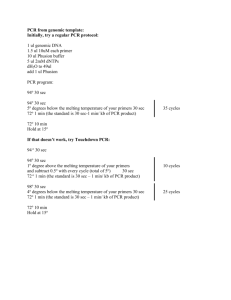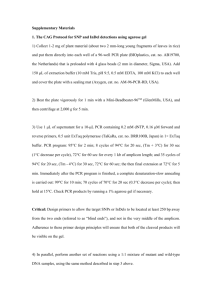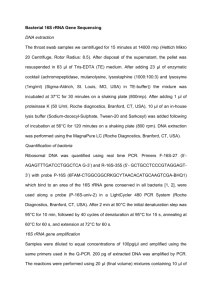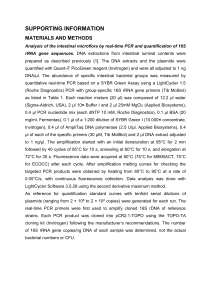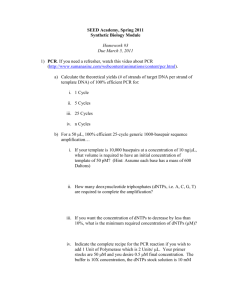Methods Supplement DNA extraction Bacterial genomic DNA was
advertisement
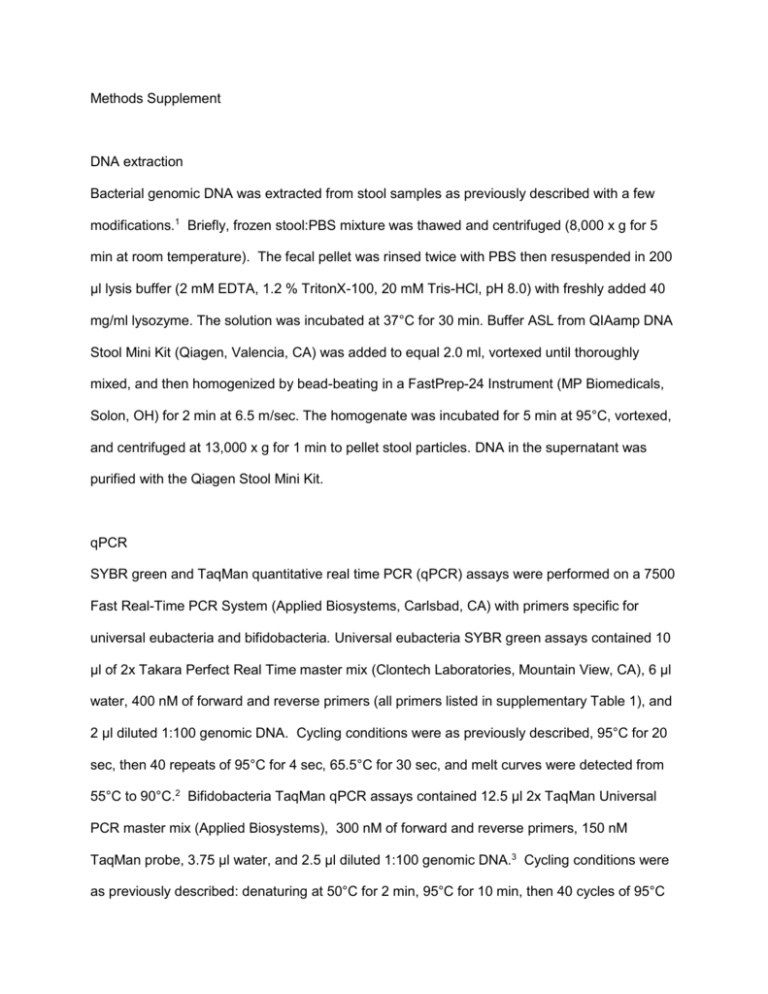
Methods Supplement DNA extraction Bacterial genomic DNA was extracted from stool samples as previously described with a few modifications.1 Briefly, frozen stool:PBS mixture was thawed and centrifuged (8,000 x g for 5 min at room temperature). The fecal pellet was rinsed twice with PBS then resuspended in 200 µl lysis buffer (2 mM EDTA, 1.2 % TritonX-100, 20 mM Tris-HCl, pH 8.0) with freshly added 40 mg/ml lysozyme. The solution was incubated at 37°C for 30 min. Buffer ASL from QIAamp DNA Stool Mini Kit (Qiagen, Valencia, CA) was added to equal 2.0 ml, vortexed until thoroughly mixed, and then homogenized by bead-beating in a FastPrep-24 Instrument (MP Biomedicals, Solon, OH) for 2 min at 6.5 m/sec. The homogenate was incubated for 5 min at 95°C, vortexed, and centrifuged at 13,000 x g for 1 min to pellet stool particles. DNA in the supernatant was purified with the Qiagen Stool Mini Kit. qPCR SYBR green and TaqMan quantitative real time PCR (qPCR) assays were performed on a 7500 Fast Real-Time PCR System (Applied Biosystems, Carlsbad, CA) with primers specific for universal eubacteria and bifidobacteria. Universal eubacteria SYBR green assays contained 10 µl of 2x Takara Perfect Real Time master mix (Clontech Laboratories, Mountain View, CA), 6 µl water, 400 nM of forward and reverse primers (all primers listed in supplementary Table 1), and 2 µl diluted 1:100 genomic DNA. Cycling conditions were as previously described, 95°C for 20 sec, then 40 repeats of 95°C for 4 sec, 65.5°C for 30 sec, and melt curves were detected from 55°C to 90°C.2 Bifidobacteria TaqMan qPCR assays contained 12.5 µl 2x TaqMan Universal PCR master mix (Applied Biosystems), 300 nM of forward and reverse primers, 150 nM TaqMan probe, 3.75 µl water, and 2.5 µl diluted 1:100 genomic DNA.3 Cycling conditions were as previously described: denaturing at 50°C for 2 min, 95°C for 10 min, then 40 cycles of 95°C for 15 sec and 60°C for 60 sec.2 All reactions were carried out in triplicate with a nontemplate control. TRFLP analysis of the fecal microbiota PCR amplification was performed in 50-µL reactions containing 1-5 ng of DNA template, 25 µL 2X Promega GoTaq Green Master Mix (Promega, Madison, WI), 1 mM MgCl 2, and 2 pmol of each primer).4,5 Each PCR was performed in triplicate and the products combined prior to purification. The PCR conditions were an initial denaturation at 95°C for 2 min, followed by 30 cycles of denaturation at 95°C for 30 sec, annealing at 50°C for 30 sec, and extension at 72°C for 2 min, with a final extension at 72°C for 5 min. Bacilli-specific TRFLP (Bac-TRFLP) was performed as described.6 PCR conditions consisted of an initial denaturation at 95°C for 5 min, followed by 30 cycles of denaturation at 95°C for 45 sec, annealing at 66°C for 30 sec, and extension at 72°C for 45 sec, with a final extension at 72°C for 5 min. PCR products were analyzed by electrophoresis and purified using the QIAquick PCR Purification Kit (Qiagen, Valencia, CA). All 16S-TRFLP amplicons were digested using the enzymes AluI, MspI, HaeIII, and HhaI. Bac-TRFLP amplicons were digested using the enzymes MseI, Hpy188I, and Hpy188III. Next, 1.5 µl of the digestion mixture was used for fragment analysis and traces were visualized with the program Peak Scanner v1.0 (Applied Biosystems). Peak filtration and clustering analyses were performed with R software, using published program scripts and analysis protocols.7 Taxonomic assignments of operational taxonomic units were based on comparison to an in silico digest database generated by the virtual digest tool from MiCA8 of good-quality 16S rRNA gene sequences compiled by the Ribosomal Database Project Release.9,10 References 1. Martinez I, Kim J, Duffy PR, et al. Resistant starches types 2 and 4 have differential effects on the composition of the fecal microbiota in human subjects. PLoS One 2010;5:e15046. 2. Hartman AL, Lough DM, Barupal DK, et al. Human gut microbiome adopts an alternative state following small bowel transplantation. Proc Natl Acad Sci U S A 2009;106:17187-17192. 3. Penders J, Vink C, Driessen C, et al. Quantification of Bifidobacterium spp., Escherichia coli and Clostridium difficile in faecal samples of breast-fed and formula-fed infants by real-time PCR. FEMS Microbiol Lett 2005;243:141-147. 4. Nadkarni MA, Martin FE, Jacques NA, et al. Determination of bacterial load by real-time PCR using a broad-range (universal) probe and primers set. Microbiology 2002;148:257-266. 5. Lane D. 16S/23S rRNA sequencing. In Stackebrandt, E., and M. Goodfellow (ed.), Nucleic Acid Techniques in Bacterial Systematics. New York: John Wiley & Sons, 1991;115-175. 6. Bokulich NA, Mills DA. Differentiation of mixed lactic acid bacteria communities in beverage fermentations using targeted terminal restriction fragment length polymorphism. Food Microbiol 2012;31:126-132. 7. Abdo Z, Schuette UM, Bent SJ, et al. Statistical methods for characterizing diversity of microbial communities by analysis of terminal restriction fragment length polymorphisms of 16S rRNA genes. Environ Microbiol 2006;8:929-938. 8. Shyu C, Soule T, Bent SJ, et al. MiCA: a web-based tool for the analysis of microbial communities based on terminal-restriction fragment length polymorphisms of 16S and 18S rRNA genes. Microb Ecol 2007;53:562-570. 9. Cole JR, Chai B, Farris RJ, et al. The ribosomal database project (RDP-II): introducing myRDP space and quality controlled public data. Nucleic Acids Res 2007;35:D169172. 10. Cole JR, Wang Q, Cardenas E, et al. The Ribosomal Database Project: improved alignments and new tools for rRNA analysis. Nucleic Acids Res 2009;37:D141-145.

